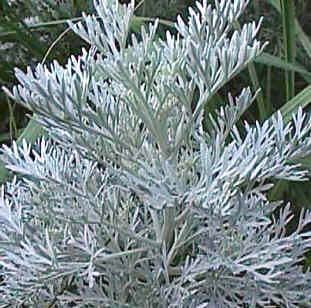
Plant Description
Caution & Interaction

Latin (botanical) name:
Artemisia Absinthium
Common names: Wormwood, Sweet Annie, Green Ginger, Annual Wormwood, Sweet Sagewort, Sweet Wormwood
Plant Description: Wormwood, native to the Mediterranean and central Europe, is now also found in Siberia, Canada, and parts of the northeastern United States. It is generally found growing wild on roadsides and wastelands. Wormwood has a perennial root, and grows from mid-summer to mid-autum. It reaches a height of approximately 4 feet. From the root, branched, leafy stems arise covered with fine, silky, grayish-white hairs. Its leaves are dark green, covered also in silky grayish hairs which gives them a downy feel, and about 3 inches long and 1-1/2 inches broad. From July to October, Wormwood blooms with small, greenish-yellow, nearly globular flowers arranged in a leafy panicle. Wormwood shrubs are very coarse, sprawling, and aromatic. Its leaves and flowers are bitter, and the leaves and roots exude a substance that restricts many other plants from growing nearby.
Medicinal Properties &Uses: The chief constituent in Wormwood is volatile oil, which contains thujone bitters (absinthum), absinthol, thujyl alcohol, bitter sesquiterpene lactone, flavonoids, and bitter glycosides. The herb also contains the tannin, resin, starch, nitrate of potash, and other salts. Traditionally, it has been used to expel roundworm and threadworm. Clinical studies have proven that Wormwood effectively increases bile, stimulates and restores poor appetite, and effectively treats a wide range of digestive problems. As a tonic, it stimulates and helps prevent liver and gallbladder problems. It can be used as an external compress to alleviate pain from rheumatism and to stimulate poor circulation. Wormwood has also been used as a mild sedative to treat anxiety and nervous disorders.
Dosage: 15-60 drops in water or juice, 2-3 times daily or as needed. Shake well before using.
Cautions & Interactions: Do not take during pregnancy. Keep out of reach of children.
Efficacy Studies & Other Clinical Data:
Disclaimer (U.S. Only): These statements have not been evaluated by the FDA. These products are not intended to diagnose, cure, treat, or prevent any disease.
Common names: Wormwood, Sweet Annie, Green Ginger, Annual Wormwood, Sweet Sagewort, Sweet Wormwood
Plant Description: Wormwood, native to the Mediterranean and central Europe, is now also found in Siberia, Canada, and parts of the northeastern United States. It is generally found growing wild on roadsides and wastelands. Wormwood has a perennial root, and grows from mid-summer to mid-autum. It reaches a height of approximately 4 feet. From the root, branched, leafy stems arise covered with fine, silky, grayish-white hairs. Its leaves are dark green, covered also in silky grayish hairs which gives them a downy feel, and about 3 inches long and 1-1/2 inches broad. From July to October, Wormwood blooms with small, greenish-yellow, nearly globular flowers arranged in a leafy panicle. Wormwood shrubs are very coarse, sprawling, and aromatic. Its leaves and flowers are bitter, and the leaves and roots exude a substance that restricts many other plants from growing nearby.
Medicinal Properties &Uses: The chief constituent in Wormwood is volatile oil, which contains thujone bitters (absinthum), absinthol, thujyl alcohol, bitter sesquiterpene lactone, flavonoids, and bitter glycosides. The herb also contains the tannin, resin, starch, nitrate of potash, and other salts. Traditionally, it has been used to expel roundworm and threadworm. Clinical studies have proven that Wormwood effectively increases bile, stimulates and restores poor appetite, and effectively treats a wide range of digestive problems. As a tonic, it stimulates and helps prevent liver and gallbladder problems. It can be used as an external compress to alleviate pain from rheumatism and to stimulate poor circulation. Wormwood has also been used as a mild sedative to treat anxiety and nervous disorders.
Dosage: 15-60 drops in water or juice, 2-3 times daily or as needed. Shake well before using.
Cautions & Interactions: Do not take during pregnancy. Keep out of reach of children.
Efficacy Studies & Other Clinical Data:
-
HerbMed - Clinical Studies
-
N. I. Yio Fiagbe PhD, BPharm, MPSG, FWAPCP - Sweet Wormwood and Artemisinin
Disclaimer (U.S. Only): These statements have not been evaluated by the FDA. These products are not intended to diagnose, cure, treat, or prevent any disease.